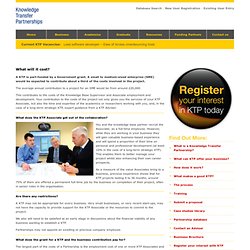

Knowledge Transfer. "Knowledge management" is something of a fad in todays business press.

At the same time, it addresses key issues that can lead to success within organizations. Knowledge management addressed how organizations can manage the knowledge embedded in its systems, and contained in the heads of its employees. It also systematically considers how advanced information technology can be used to leverage existing knowledge and create new knowledge. This essay discusses one aspect of knowledge management, knowledge transfer: how to move good ideas from one part of an organization to others that can use the information. Knowledge transfer has always been a challenge for organizations. Knowledge transfer is only valuable when it is integrated into a set of policies for knowledge generation and capture. In principle, knowledge transfer can be broken down into distinct stages. How Management Can Promote Knowledge Transfer Training: Managers and workers must be trained to evaluate new ideas. Knowledge Transfer Partnerships. What would really make a difference to your organisation?

A better product, an improved process, a new technology? A Knowledge Transfer Partnership (KTP) is a tried-and-tested government programme which brings an ambitious graduate, supported by a university specialist, into your company to lead a project and make that difference. And a smaller organisation pays just one third of the cost! KTP Associate Charlie Symonds, who developed a sustainability strategy for Stannah Stairlifts Many thousands of companies have already benefited from KTP, and you can see some examples on our Case Studies page. An increase of over £365k in annual profits before taxthree genuine new jobs21 additional staff trained Other benefits include access to the latest research and an embedding of innovation culture.
What types of organisation take part? EXAMPLE: Knowledge Transfer Partnerships (KTP) - What will it cost my business? A KTP is part-funded by a Government grant.

A small to medium-sized enterprise (SME) would be expected to contribute about a third of the costs involved in the project. The average annual contribution to a project for an SME would be from around £20,000. This contributes to the costs of the Knowledge Base Supervisor and Associate employment and development. Your contribution to the costs of the project not only gives you the services of your KTP Associate, but also the time and expertise of the academics or researchers working with you, and, in the case of a long-term strategic KTP, expert guidance from a KTP Adviser.
What does the KTP Associate get out of the collaboration? You and the knowledge base partner recruit the Associate; as a full-time employee. Are there any restrictions? A KTP may not be appropriate for every business. We also will need to be satisfied at an early stage in discussions about the financial viability of any business wanting to establish a KTP. Business budgeting. How the KTP Budget Works for an SME.
KTP Process (see slide #4 for details on COSTS) Free SWOT analysis template and method, SWOT analysis examples. As a more general guide, here is a free SWOT analysis template worksheet (doc file), and the same free SWOT analysis tool (pdf format).

If you have difficulty opening the above doc file here are two other formats: A SWOT analysis measures a business unit, a proposition or idea; a PEST analysis measures a market. A SWOT analysis is a subjective assessment of data which is organized by the SWOT format into a logical order that helps understanding, presentation, discussion and decision-making. The four dimensions are a useful extension of a basic two heading list of pro's and con's (free pro's and con's template here). SWOT analysis can be used for all sorts of decision-making, and the SWOT template enables proactive thinking, rather than relying on habitual or instinctive reactions.
The SWOT analysis template is normally presented as a grid, comprising four sections, one for each of the SWOT headings: Strengths, Weaknesses, Opportunities, and Threats. Here is the explanation in more detail: